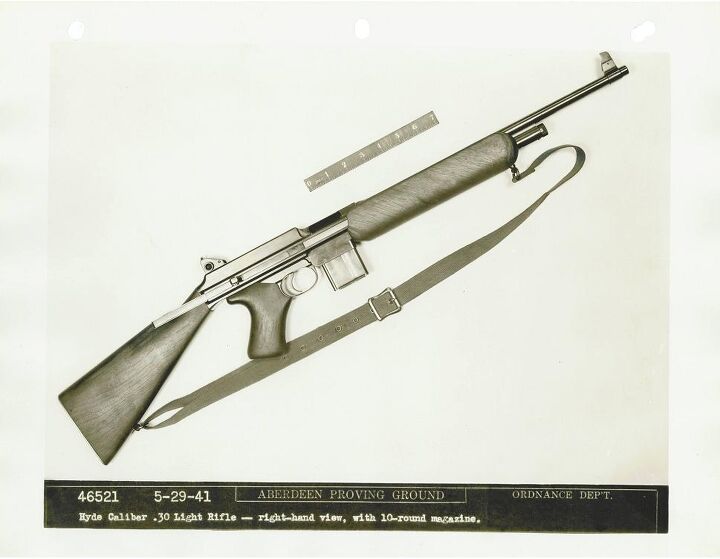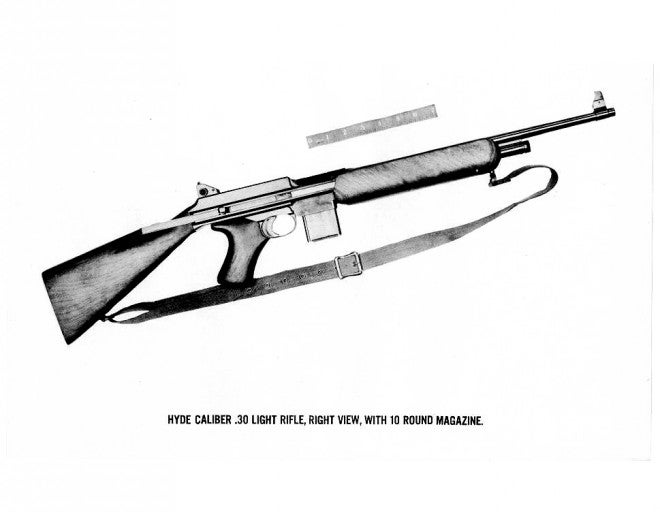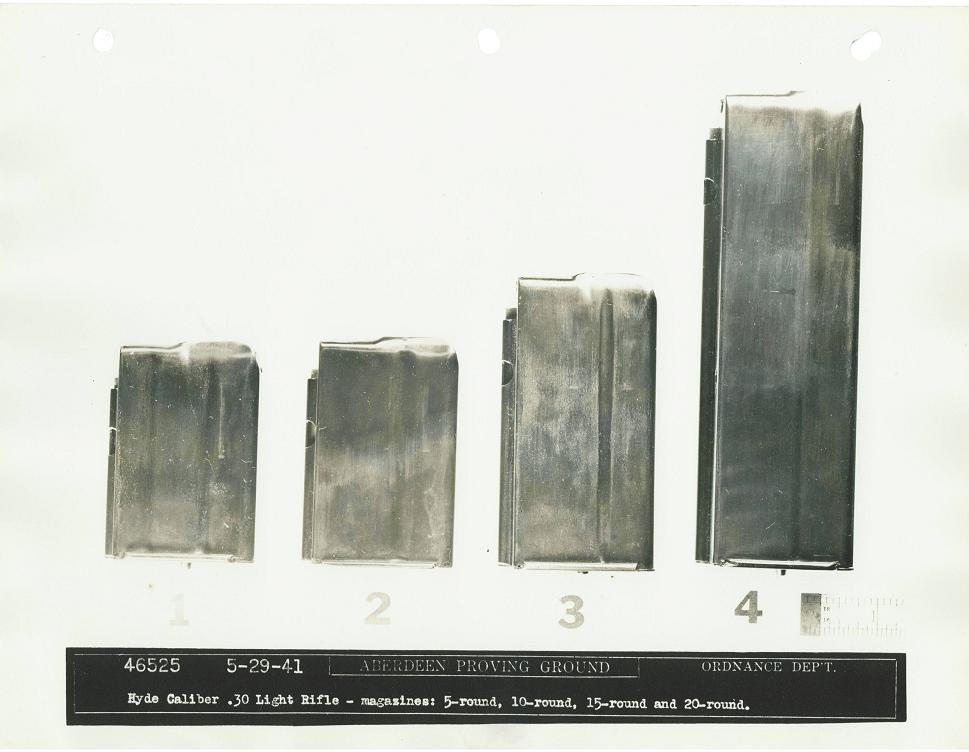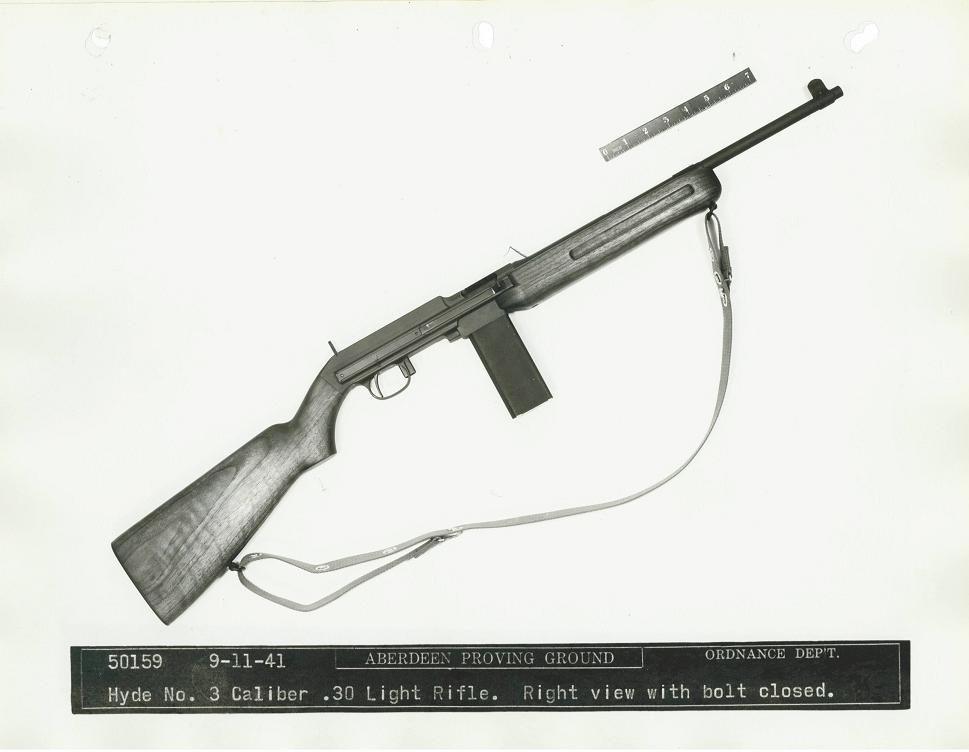Well, sort-of-not-really, although it makes for a pretty great title. The Bendix-Hyde Carbine was in fact one of the nine prototypes initially submitted to the Light Rifle program (not to be confused with the Lightweight Rifle program that is the subject of my ongoing series), and it’s in many ways the most interesting one to me. First, though, a brief overview of George J. Hyde, the brilliant designer who invented it:
George Hyde was a very talented small arms designer, having previously created the Hyde Model 35 submachine gun which was one of the very few competitors to the M1928 Thompson in the 1930s. The Hyde Model 35 was a very good design, being cheaper to make than the Thompson – the cost to produce a single Model 35 was $75 in 1936, and the guns sold for $125, compared to a $175-$225 tag for the Thompson during the same period. In 1939, the Model 35 was tested at Aberdeen Proving Grounds, and was found there to be a controllable and ruggedly reliable gun that resisted the elements well. However, production of the Model 35 never got off the ground, and only somewhere between 86 and 101 were ever made.
In the mid-1940s, Hyde also developed a .30 Carbine caliber blowback weapon designed with cheap, stamped construction and an MG-42-style quick-change barrel. Whether this rifle was solicited by the Army, or even what role it was intended to fill, is unknown.
Hyde’s most historically significant projects, though, were two other submachine guns, both adopted by the US Army during World War II as the M2 and M3 Submachineguns. Only 400 or so of the M2 were ever made, but over 700,000 of the excellent and extremely inexpensive M3 “Grease Gun” (which by 1945 cost less than a tenth what the M1928A1 Thompson cost) were built, and those served the Army into the 1990s.
The Bendix-Hyde Light Rifle was one of two rifles that in the first round of trials impressed testers the most, the other being Springfield Armory’s submission designed by none other than John Cantius Garand. What made the Bendix-Hyde unique among the initial entrants was its submachine gun-like appearance, having a separate pistol grip and stock – something that would become closely associated with the assault rifle concept in the latter half of the 20th Century.

Raised sights, a sleek, compact receiver, pistol grip, and forward-mounted magazine well all give the Bendix-Hyde a very modern appearance. Image source: forgottenweapons.com
But the rifle is interesting not only for its looks. The rifle with its pistol grip and sleek appearance also was a select-fire weapon, a characteristic that was originally a part of the Light Rifle solicitation. It utilized an action that combined elements from both the M1 Garand and the Browning BAR, using a doglegged direct-gas piston operating rod with nested spring in conjunction with a fixed bolt and wedge-shaped locking piece that tilted upwards into the receiver. These two elements would again be combined in the .30 Light Rifle caliber Earle Harvey-designed T25/T47 rifle as part of the Lightweight Rifle program of the 1950s.
Weighing in at 5.35 pounds unloaded with a sling and an empty 5-round magazine, the Bendix-Hyde was very light, although not quite as light as the sub-5lb Winchester entry that became the M1 Carbine. However, the Bendix-Hyde could have given substantially better performance versus the historical M1, had it been adopted. Hyde’s design practices had followed the closed-receiver design model, proven to be very dust and debris resistant. This layout suggests superior performance in adverse conditions versus open-action weapons like the M1 Carbine, and the testing at Aberdeen Proving Grounds backs up this hunch:
4. Its general functioning was excellent except for failures of the mechanism to close. This was felt correctable by use of a stronger operating spring.
5. Endurance was excellent, with the exception of the connecting rod. It was suggested that this could be corrected by a better method of fabrication of this part.
6. Its accuracy at 100 yards was excellent, although at 300 yards the extreme spread was somewhat greater than expected.
7. Recoil was very light.
8. Functioning in simulated rain was fair, and its functioning in dust was excellent.
9. Its functioning when held in unusual positions and when held lightly was excellent.
10. In ease of care, disassembly, etc. the rifle was excellent.
11. The rifle was excellent in ease of hand operation, except for the fact that the operating handle was not connected to the bolt so that the latter could not be pushed closed.
In addition, remember that the magazine pattern of the M1 Carbine is very poor, being too thin and flimsy, as well as having generally poor design. It is the weak point of the M1 Carbine from a functioning perspective, and it seems very likely that the Bendix-Hyde pattern magazine would have been superior. Another detail improvement of the Hyde versus the M1 Carbine is the dust cover on the Hyde’s operating rod. This would prevent oprod dismount, the serious malfunction discussed in yesterdays article, and something that can happen to the M1 Carbine as well as the M1 Garand.
After the first round, Ordnance ordered five more Bendix-Hyde carbines for the second round of tests. However, the company Hyde was working with, the Firearms Research Corporation, could not make the five rifles within the deadline, so Bendix Aviation Corporation turned to the Inland Manufacturing Division of General Motors. This resulted in an incredibly rushed development of the second Hyde Carbine, which dropped the distinctive pistol grip for a more traditional layout, as well as the automatic fire provision. It was also longer, and about half a pound heavier than the original model.
Unfortunately for Hyde, the new rifle had not been fully troubleshooted, and performed much more poorly in the tests. The feedback received from testers during a 1,000 round abbreviated functioning test suggests the design was undergassed, but the deathblow had already been dealt. One of the five Hyde Carbines was again tested in a grueling 10,000 round “Sudden Death” round, from which the Winchester design emerged victorious, being recommended for adoption by all members of the subcommittee.
I have embedded Forgotten Weapons’ recently released video on the Inland-Hyde Carbine below:
The turn of events at the Sudden Death trials created what I think is one of the major “might-have-beens” of the war. The Hyde Carbine came very close to being adopted, and was in my opinion the superior design to the Winchester Carbine. Its rugged, sealed construction, stock/receiver interface (which would have simplified design of a folding stock, and could have resulted in a far better stock than the M1A1’s flimsy side-folder), and better pattern magazine (probably) would have all likely helped the “Hyde M1 Carbine” perform better than the historical M1.
In the 1950s, the M1 Carbine received serious negative publicity. After action reports from both World War II and the “police action” in Korea, chiefly those written by S.L.A. Marshall, resulted in the handy little Carbine being seriously questioned as a weapon of war, and lent momentum to the effort to adopt a “universal” weapon to replace Carbine, Rifle, Submachinegun, and Automatic Rifle all with a single small arm. If the Hyde had been adopted instead of the Winchester, would its more sound design have helped soften Ordnance to the idea of a lighter weight intermediate caliber weapon? Would a replacement program for a dedicated carbine have been initiated, rather than the whole concept abandoned until it was revived in the late 1980s?
And today, would we think of an M1 Hyde Carbine with its aggressive looks and pistol grip layout as more than a mere personal defense weapon?
Who knows!
–
George Hyde’s patents can be found here. The patents listed under the Firearms Research Corporation can be found here.
 Your Privacy Choices
Your Privacy Choices


